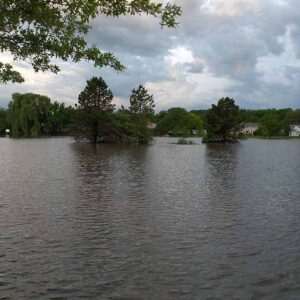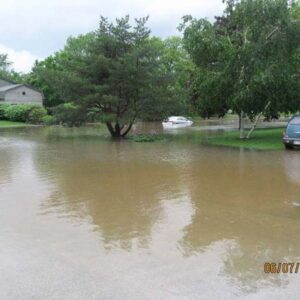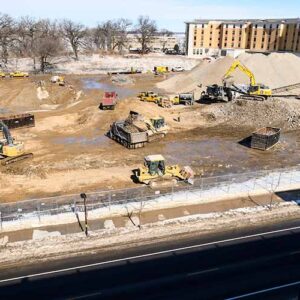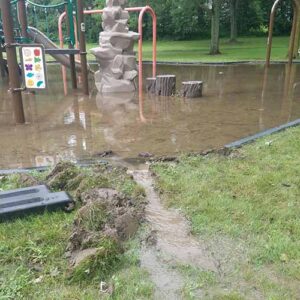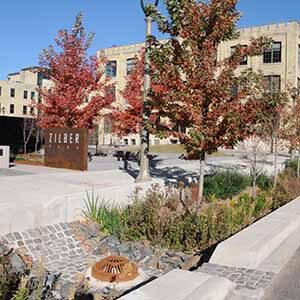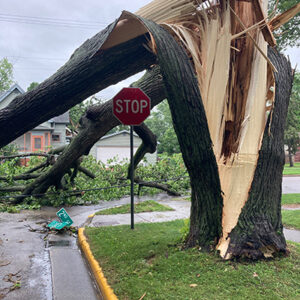Follow the Infrastructure Working Group on Twitter:
Infrastructure is the backbone of any modern society. Infrastructure includes roads, rails, and ports, a system of facilities to facilitate the movement of goods and people. Included in infrastructure is water treatment, wastewater and stormwater systems. Civil or environmental engineers design these systems; however many occupations are involved in the planning, maintenance and daily operations.
The Infrastructure Working Group (IWG) formed in 2020 to address technical issues that the engineering community faces in designing, operating and maintaining Wisconsin’s infrastructure and future considerations for the construction sectors.
The IWG’s leadership expertise is in water resources — stormwater, transportation, hydrology, and construction materials. Other infrastructure such as broadband, energy, hazardous waste, inland waterways, public parks, schools, or transit are not in scope for this group.
Infrastructure Issues in Wisconsin
Public infrastructure managers face many challenges in maintaining the infrastructure system in Wisconsin. Aging infrastructure tops the list in a survey conducted in 2020 of public infrastructure managers, elected officials, planners, and infrastructure consultants.
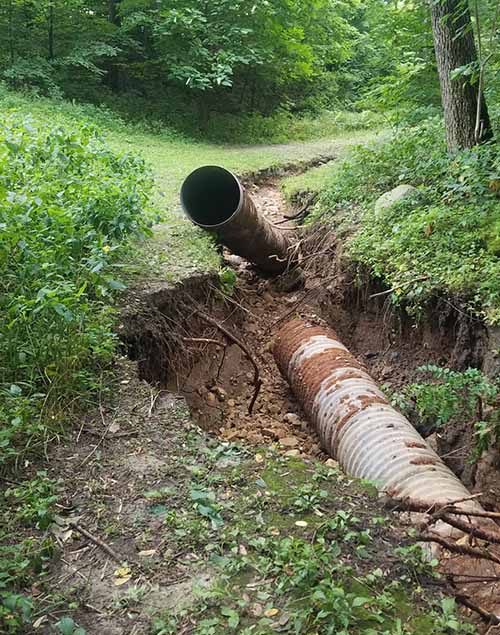
Replacing infrastructure is a high-cost investment that officials must balance among other needs in a community. Disasters disrupt community priorities, such as when flooding results in road washouts. Communities are suddenly faced with reconstructing a road. A second concern for infrastructure managers, planners, elected officials and infrastructure consultants in Wisconsin is pavement deterioration, which is also an issue for users as roads will impact travel speed and wear on tires.
Inadequate capital funding and insufficient revenues from taxpayers to cover operations and maintenance costs are common concerns among municipalities which can further impact when to replace aging infrastructure.
The combination of these concerns hints that our current funding system is not working. We need to redesign a more sustainable funding stream to address aging infrastructure and pavement deterioration, as well as other infrastructure problems. To complicate matters, the uncertainty of the frequency of future climate impacts and how to design future infrastructure is a design engineer’s concern.
The Infrastructure Working Group has identified updating rainfall data as its signature contribution to the design community. The Wisconsin Rainfall Project helps to change the mindset of using historical data to predict future rainfall to developing a data set that projects rainfall into the future. This product will help managers “adapt” to climate change.
A second contribution is the development of a baseline of practice in Wisconsin that documents issues and barriers facing professionals associated with infrastructure management. This is summarized in the Wisconsin Infrastructure and Climate Change Survey 2020 report.
A third contribution is a roadmap for measuring the carbon footprint of construction projects, beginning with mining of raw materials, to transportation and installation. This project is a first step in mitigating or reducing carbon emissions in Wisconsin.
With the likelihood of federal infrastructure funding to rebuild and address climate change impacts, along with the Justice40 Initiative, infrastructure managers have an opportunity to make their communities resilient for all residents.
Summary of Climate Issues
Learn about the impacts to different types of infrastructure resulting from more frequent, intense rainfall.
Airports
- Pavement deterioration
Bridges, Culverts and Dams (Hydraulic Structures)
- Roadway culvert and bridge failure due to overtopping flow
- Bridge structure and footings failure due to increased discharge
- Embankment and retaining wall failure due to overtopping in floods
- Dam spillway failure due to inadequate capacity
- Continued and exacerbated disconnection of stream segments due to covert capacity and invert alignment
Drainage Systems
- Inaccurate and underestimated hydrologic design of stormwater management and river crossing structures
- Exacerbated urban flooding in both storm drainage and urban watercourses
- Underestimation of floodplain storage benefits, water velocities and public safety risk
Runoff Quality
- More precipitation, especially more early and late-season precipitation will produce higher rural and urban sediment and water quality runoff loading.
- Higher runoff volume rates will reduce performance of urban stormwater management systems including infiltration basins and water quality treatment ponds.
Roads and Rails
- Road and rail washouts
- Rockslides
- Damage to road right-of-way that undermines roadbeds
- Potholes
Sanitary Sewer Systems and Wastewater Treatment Facilities
- Possible increased groundwater elevations producing more sanitary sewer infiltration driven by larger precipitation depths and more fall and early spring recharge
- Increased surface water runoff flooding producing increased inflow into sanitary sewers leading to more sanitary sewer overflows
Learn about the impacts to different types of infrastructure resulting from higher temperatures in general, and more intense and longer duration summertime heat waves.
Airports
- Economic impact due to less revenue or high development costs.
- At higher temperatures, airplanes need longer runways to be able to take-off. If runways are too short, airplanes have to restrict the weight onboard (remove passengers and cargo). If airports have land, runways will need to be extended. Runway extensions will extend the noise impacts to new surrounding areas, commercial or residential.
Roads
- Pavement buckling results in unsafe infrastructure.
- Detours/congestion impact workers and traveler trips.
- Congestion and detours for freight trucks ultimately lead to higher costs for the consumer.
- Congestion impacts air quality.
Bus Stops, Transit Stops
- Hotter days will require different types of materials that do not contribute to the urban heat island.
Wastewater Treatment Facilities
- Increased temperatures could affect water treatment chemistry or biology.
- Increased cooling load to all infrastructure operation, maintenance, and administration operations.
Learn about the impacts to different types of infrastructure resulting from potentially higher lake levels.
Ports, Harbors, and Marinas
- Potential damage to roads and rails connecting ports for “last mile.”
- Damage to commercial ports
- Higher insurance claims for port tenants may mean a change to trucking instead of water movements which would bring higher costs to consumers.
- At higher lake levels freighters can accommodate higher tonnage. Typical commodities are too heavy to transport by truck.
- At lower lake levels, freighters and barges are limited in the amount of tonnage they can carry, resulting in economic loss.
Learn about the impacts to different types of infrastructure resulting from higher precipitation and decreased frozen ground conditions, which produce increased groundwater recharge and a higher water table.
Groundwater
- Increased groundwater-driven flooding such as has occurred at Spring Green and in Waukesha County
- Increased duration of saturated conditions adjacent to structure foundations
- Increased infiltration into piped infrastructure such as sewers
Strategies for Infrastructure Managers
A vulnerability assessment is a first step in determining the climate risks for any type of infrastructure. The following strategies could be part of an infrastructure manager’s roadmap for adapting to climate change or mitigating greenhouse gasses. Strategies could also provide community co-benefits ranging from improvements in air quality, use of trees for shading, or improvements in noise levels. A second strategy is to develop scenarios that reflect three climate scenarios.
This is an accordion element with a series of buttons that open and close related content panels.
Ports Manager
- Vulnerability analysis of shoreline protection systems to fluctuations in lake stage
- Evaluate vulnerability of existing port and harbor structures such as breakwaters and harbor wall
- Elevate and reinforce transportation connections to critical infrastructure
- Relocate or consolidate port functions
- Install systems to adapt to current high lake levels, considering potential future lake level variability
- Build adaptive facilities using waterproof materials in the interiors
- Select tenants with environmental, social, and governance (ESG) goals
- Identify options for and support adaptive recreational facilities such as floating dockage structures and modified boat launch ramps
- Create a redundant system for industries by building sustainable rail connections
- Implement marine highways for Interstate 94
- Electrify and convert to solar for sustainable energy. Use cool roofs. Hydrogen
Roads Manager
- Funding for elevating road and rail infrastructure
- Updated asset management models to include climate factors
- Use of sensors to monitor conditions, self-diagnose issues. “Smart structures” for higher cost effectiveness
- Pilot and transition to fossil free materials
- Use of hyper-performance materials
- Use of construction robots for pothole patching, joint repairs, crack detection and sealing, and asset inspections
- Partner with the private sector to establish electric-only bids for freight movement for long- and short-haul goods movement
Bridge/Culvert/Dam Manager
- Use updated rainfall data in hydrologic and hydraulic design.
- Evaluate and communicate methods for predicting future probability of annual peak discharge utilizing updated rainfall data.
- Inventory and prioritize stream crossing structures with respect to vulnerability to failure.
- Develop and promote a flooding risk-based approach (instead of a predefined “design storm” requirement) for drainage structure capacity analysis for urban drainage bridges and reservoirs.
- Use adaptive design approaches that allow for future modifications to be planned for in advance, depending upon continuing climate change effects.
- Revise design standards in administrative code and guidance documents on state and municipal level to require updated design procedures for bridges, dams, drainage system structures as described previously.
- Promote the use of sensors to monitor conditions, self-diagnose issues. Build “smart structures.”
- Provide updated guidance on structure inventory, critical ecological/hydrologic/hydraulic design issues and latest data on precipitation in hydrologic modeling approaches.
- Communicate benefits of culvert (and bridge) design using stream simulation design process.
- Provide guidance to use stream simulation design as well as other design approaches for stream-crossing culverts, especially in rural areas, to assess vulnerability and produce more flood resilient designs that also protects aquatic communities.
- Communicate examples of culvert structures that have survived extreme floods to provide lessons learned and encourage municipalities and designers that design for flood resilience is possible.
Construction Manager
- Conduct research and consolidate existing data to identify top construction material and construction process greenhouse gas emission issues in Wisconsin.
- Develop a metric for identifying embedded carbon content that can be applied to many materials, similar to an “Energy Star” designation.
- Develop and adopt specification and bidding procedures that value reduced carbon content materials.
- Provide contract flexibility for loss of working days due to extended rainfall or other climatic effects, and also incentivize contractors to partner with the owner in planning to address climatic extremes that may be encountered during a particular contract performance timeframe.
Water Resources Program Manager
- Programs to assess the potential for groundwater rise in areas of critical infrastructure.
- Assessment of community-wide impacts of structure flooding in areas determined to be vulnerable.
- Infrastructure facility master planning to include evaluation of climate change changes in saturated ground duration and elevation.
- Modify modeling guidance for urban and rural runoff quality modeling approaches to account for potential higher loading rates.
- Evaluate vulnerability of existing stormwater quality infrastructure to increased runoff volume and nutrient/sediment loadings.
- Develop updated approaches to floodplain definition that combine FEMA standards for flood insurance and provide more comprehensive information for planning and floodplain land use limitations.
- Provide guidance for and require that urban drainage master plans include a climate change vulnerability analysis, specifically evaluate distributed green infrastructure, and provide some type of incentive funding for these evaluations.
- Provide technical and procedural guidance regarding the use of natural systems such as floodplain storage and wetland restoration as part of watershed quality management in rural areas and provide some type of incentive funding for these evaluations.
Sanitary Sewer Systems and Wastewater Treatment Facilities Managers
- Conduct vulnerability analysis of systems and treatment facilities to increased precipitation, street flooding and groundwater elevations.
- Replace and repair leaking infrastructure.
- Consider increased infiltration and inflow when designing wastewater treatment facilities.
- Consider increased potential for infiltration and groundwater elevations in private septic system design.
- Raise outfall structures and wastewater treatment facilities where there is risk of backflow to the wastewater treatment facility during flood events.
- Upgrade equipment and facilities to reduce energy .use.
- Implement operational changes to improve plant efficiency.
- Implement more efficient utility customer energy use, for example requiring or subsidizing more efficient water heating.
- Require long-term cost/benefit analysis of natural systems and green infrastructure as part of new infrastructure projects.
- Conduct specific evaluation of climate-related increased temperatures in all infrastructure operation equipment and facilities planning, especially public potable water supplies.
- Develop updated rainfall statistics for Wisconsin using latest techniques for both current and projected future conditions.
- Communicate new rainfall data to designers statewide.
- Develop and communicate updated recommendations for rainfall/runoff analysis to define climate and watershed land-use conditions that should be evaluated in existing conditions and future flooding calculation.
- Develop guidance from modeling standards for storm recurrence intervals and rainfall distributions appropriate for future precipitation conditions.
Solutions
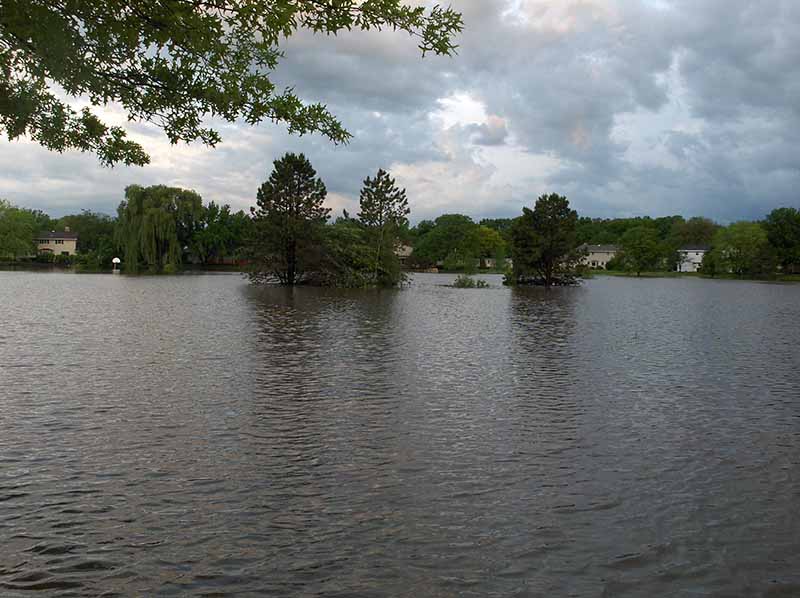
Many strategies are operational solutions, meaning “doing more of something.” For example, filling more potholes. A true solution, however, would be aimed at the reason why potholes form in the first place. Advances in new materials such as self-healing pavements and smart concrete may make roads less expensive to maintain in the future.
An operational solution around heat affecting airplane takeoff may be to change the timing of flights to cooler times of the day. A longer-term solution would be to re-design the aircraft using lighter materials that resist hotter temperatures.
Many technologies are being developed to mitigate climate change, some that could be incorporated into the infrastructure, where the infrastructure itself captures or regenerates energy or carbon. One early-stage technology is using wireless to regenerate electric bus batteries so that there is no downtime for charging the fleet.
Besides technology solutions waiting to make it to market, there is other information infrastructure managers need to understand about the risks, return of investment and the opportunities of making infrastructure more resilient to the impact of climate change in Wisconsin and accelerating decarbonization.
This is an accordion element with a series of buttons that open and close related content panels.
The Business Case for Adapting Our Infrastructure
In response to the Infrastructure Working Group survey, 49 percent of respondents said adapting to climate change is too expensive.
Twenty-three years of data from the Federal Emergency Management Agency (FEMA) shows that there is at least a $4 return on every dollar invested in adaptation. If adaptation involves changes in administrative codes, such as building codes, subdivision ordinances, construction standards, and building design standards, the return can be as high as $7. It is clear that well-planned adaptation can save money. Adaptation returns $4 for every $1 Invested.
Understand the Level of Your Community Resilience
What if there is major flooding in your community? We may know how many people may be impacted by the event. But do we know how resilient our community is? How long will it take people to recover from the event? These are questions that researchers are asking.
In 2020 the U.S. Census produced its Community Resilience Estimates Dashboard. The project identified the following risk factors:
- Income to poverty ratio
- Single or zero caregiver household
- Crowding
- Communication barrier
- Unemployment
- Disability
- No health insurance
- Age 65 or over
- Heart disease
- Diabetes
- Respiratory disease
The dashboard shows that, on average, a quarter of Wisconsin’s population has three or more risk factors, making these individuals more likely to have a difficult time recovering from a disaster. Furthermore, 50 percent of Wisconsin’s residents have one or two of these risk factors.
Climigration
The Midwest is positioned as a destination to migrate for people who have experienced environmental disaster. Municipalities are already considering this scenario and determining how many residents can be accommodated with their current infrastructure systems. Climigration should be considered an opportunity for municipalities as people may flee from rising sea levels from the U.S. coasts, wildfires and poor air quality in the West, and extreme heat from many parts of the country.
Infrastructure Working Group Policy Recommendations
- Support the creation of a Wisconsin Green Compact for municipalities to accelerate adaptation and climate mitigation. Compact would ensure alignment with state, regional and national goals and provide a way to measure our collective impact. A compact would also be a good step in creating regional climate action and climate resilience plans.
- Pursue climate bonds to accelerate green actions.
- Build capacity for climate financing solutions in the transportation infrastructure sector.
- Investigate an integrated model such as the Transportation and Climate Initiative (12 Northeast and Mid-Atlantic states), a regional low-carbon transportation program to reduce climate-changing emissions and invest in cleaner transportation, healthier communities, and more resilient infrastructure (carbon-taxing).
Infrastructure Working Group's Action Plan
- Develop updated rainfall statistics for Wisconsin using latest techniques for both current and projected future conditions
- Communicate new rainfall data to designers statewide
- Develop and communicate updated recommendations for rainfall/runoff analysis to define climate and watershed land-use conditions that should be evaluated in existing conditions and future flooding calculation
- Develop guidance from modeling standards for storm recurrence intervals and rainfall distributions appropriate for future precipitation conditions
Environmental Climate Justice Issues

As pressure to develop increases, environmental and climate justice concerns are present in the design, operation, management, and financing of Wisconsin’s infrastructure.
Planning of Adaptation Projects
The planning process and prioritization of where investments are made (e.g., what side of town) can have huge implications for a community’s resilience in the face of environmental pollution and/or climate change. These planning decisions often include a cost-benefit analysis. This analysis should be based on a comprehensive vulnerability analysis and alternatives development and selection that includes the social costs of project impacts to properly ensure environmental and climate justice.
Reducing the Embedded Carbon Content of Construction Projects to Help Mitigate Greenhouse Gas Emissions
As planners and contractors start thinking about how to account for the carbon emissions released to create construction products (the “embedded carbon content”), like concrete and steel, decision makers must ensure that the final process for doing so is equitable. Currently, Wisconsin is in the planning phases for considering these emissions. However, we know that smaller contracting businesses will be less equipped to make the large adjustments required to their business and processes. Decision makers must ensure these smaller businesses receive additional support in making transitions to sustainable practices so they are not left behind in the marketplace.
According to the Justice40 Executive Order, “The order catalyzes the creation of jobs in construction, manufacturing, engineering and the skilled-trades by directing steps to ensure that every federal infrastructure investment reduces climate pollution and that steps are taken to accelerate clean energy and transmission projects under federal siting and permitting processes in an environmentally sustainable manner.”
A climate and economic justice screening tool will be developed by the Council on Environmental Quality to aid in identifying targeted communities.

